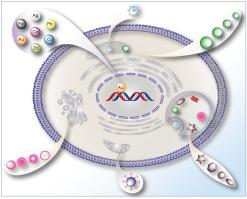Materials Today Communications ( IF 3.8 ) Pub Date : 2020-09-20 , DOI: 10.1016/j.mtcomm.2020.101692 Robin Augustine , Anwarul Hasan , Rosita Primavera , Rudilyn Joyce Wilson , Avnesh S. Thakor , Bhavesh D. Kevadiya

|
The utilization of nanomaterials in the biological and medical field is quickly progressing, particularly in areas where traditional diagnostics and treatment approaches have limited success. The success of nanomaterials in medical products such as biomedical implants, wound dressings and drug delivery systems rely upon their effective interaction between the extracellular matrix, cells, and intracellular components. Upon contact with mammalian cells, nanoparticles (NPs) begin to interact with the extracellular matrix, cell membrane, cytoplasmic proteins, nucleus, and other cellular organelles, which result in nanoparticle internalization and subsequent cellular responses. Such responses elicited by the mammalian cells as a result of the cell-nanomaterials interactions, both at the cellular and molecular level, are mainly determined by the morphological, chemical, and surface characteristics of the nanomaterials themselves. This review provides an overview of how such different attributes, such as chemical nature, size, shape, surface charge, topography, stiffness, and functional features of nanomaterials, influence the cell-nanomaterials interactions.
中文翻译:

细胞对纳米颗粒的吸收和保留:对颗粒性质以及与细胞组分相互作用的见解
纳米材料在生物和医学领域的利用正在迅速发展,特别是在传统诊断和治疗方法取得成功的领域。纳米材料在医疗产品(如生物医学植入物,伤口敷料和药物输送系统)中的成功取决于它们在细胞外基质,细胞和细胞内组分之间的有效相互作用。与哺乳动物细胞接触后,纳米颗粒(NPs)开始与细胞外基质,细胞膜,细胞质蛋白,细胞核和其他细胞器相互作用,从而导致纳米颗粒内部化和随后的细胞反应。哺乳动物细胞由于细胞和纳米材料在细胞和分子水平上的相互作用而引起这种反应,主要由纳米材料本身的形态,化学和表面特性决定。这篇综述概述了纳米材料的这些不同属性(如化学性质,大小,形状,表面电荷,形貌,刚度和功能特征)如何影响细胞-纳米材料的相互作用。



























 京公网安备 11010802027423号
京公网安备 11010802027423号